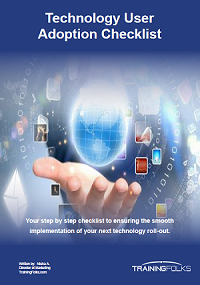Selecting a Training Company to Implement Technology and Change
As a Leader, you likely have goals to implement strategic initiatives that keep your business running or more so implement new ideas that compete in a world of innovation, growth and constant change.
It’s likely your new technology or project has a goal to increase profitability, find synergies or fix a problem you deal with. If this goal isn’t achieved, you learn from it and try something else.
However, some businesses don’t have the luxury to try again and again. Often, failed projects get shelved without the opportunity to mature and evolve or without the company learning what went wrong.
Cost and Impact of Change Is an Issue
You may have heard of some ideas that your competitors are implementing; Workday software for example helps you empower your employees. Many large companies are implementing large scale projects, but often find that the transition from ‘business as usual’ can be difficult.
Often, new technologies are implemented with little evaluation or analysis because you hope your team will use and like it. You may think that these technologies are simple to use and provide many features to help employees, yet you see your teams struggle with adoption. People may not use your new software to its full potential, or even worse – not at all.
Benefits of Technology Solutions
Implementing technology and change is more than just putting the technology into your systems and hoping that your team use it as it is intended. Many large systems in organizations today are purchased from large corporations – Workday, SAP, SAS or Cisco, and when new technology is introduced with little introduction or no training, many employees don’t understand the purpose or the benefits which leads to low user adoption.
Companies are moving away from customizing these applications to their own benefit as customizing requires detailed analysis, large project team engagement and potentially large project costs.
However, without the benefit of true customer insight what often happens is you build technologies that you already have, but different.
Working with partners who understand this technology can help you move quickly through your project timelines.
GAP Analysis
The key to successfully implementing these large initiatives is evaluating what requirements you have, or what it is you and the team are missing. Then, understanding how your business will change.
What do you do today that will be different tomorrow?
-
Understand the features of the technology – what is new and different, what is the same?
-
Conduct a detailed ‘use case’ session with your team to identify the gaps
-
Ensure you are clear on what the benefits are to this change
-
Begin identifying stakeholders – as you implement your technology. It is important to understand who your user is and how they can advocate its use

Change Management
The impact to the end user is often overlooked with the simplicity of the technology. Assessing the impact of the change to your stakeholders at the same time you are conducting your gap analysis is important to not miss any people or processes during the transition.
-
Conduct a detailed stakeholder impact assessment
-
Who will this change impact and how can you engage them? Complete a documented list of names and the impacts big or small
-
Identify key people from the organization that can weigh-in on the change
Those that are identifying the gaps in your processes will be important people that you need to transition. They could resist your plans or shut them down
-
Determine the right tactics for the change for the right audience
Particularly the training needs required. You may need in class facilitation. Virtual class facilitation with remote teams are also
-
Ensure the benefits for the change are communicated clearly and frequently
Ongoing Support
When implementing new technology or change to your organization, it is important to ensure you offer plenty of advance warning of the upcoming change along with plenty of ongoing support to ensure staff are comfortable with the changes.
-
Change of this sort does not end with the technical implementation – Include some tips to ensure employee adoption
-
Ensure you have reporting and metrics to communicate the success of training and communicate this to your team often
-
Follow up with your end users frequently. Are they understanding the change? Are they feeling comfortable?
-
Build a sustainment plan that ensures that training isn’t forgotten about. Ensure your leaders continue the momentum until the training tactics have been adopted
-
Frequently follow up with your staff on how they feel, and what are they observe.
Existing technology will help you bring change to your business faster without upfront development costs, however, it doesn’t mean the change is easy for your employees. Implementing the right training and change management tactics will help you minimize employee errors and change fatigue so that your business benefits from the change quickly and without incident.
If you are ready to implement a new technology or considering the impact it could have on your business, download our Technology User Adoption Checklist for a step by step guide.


